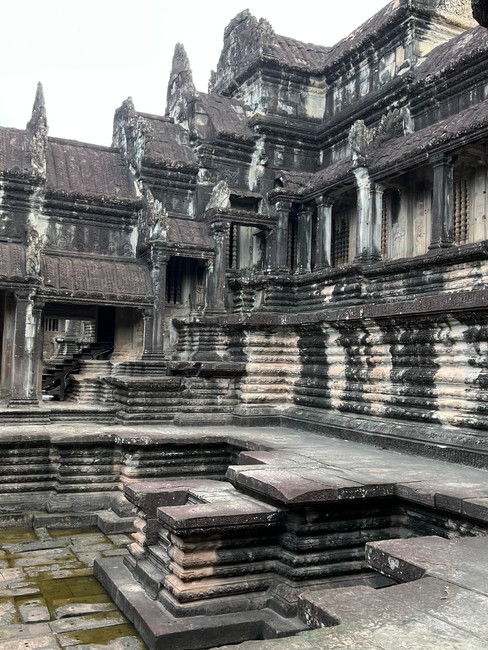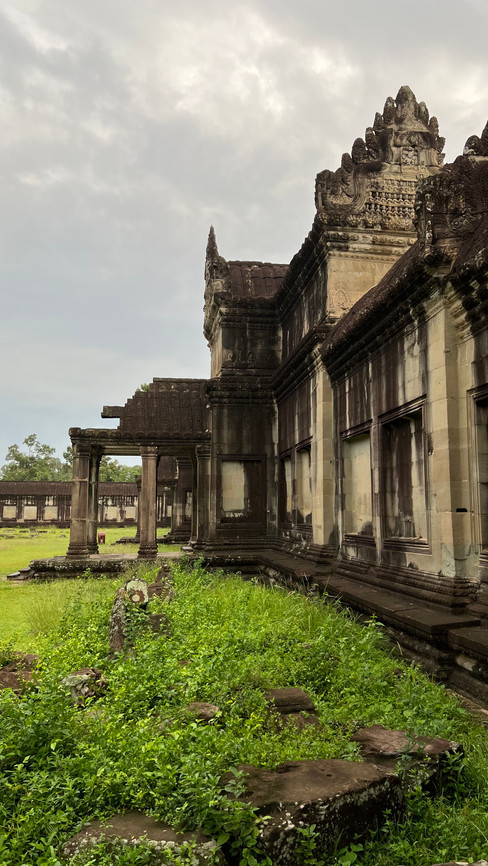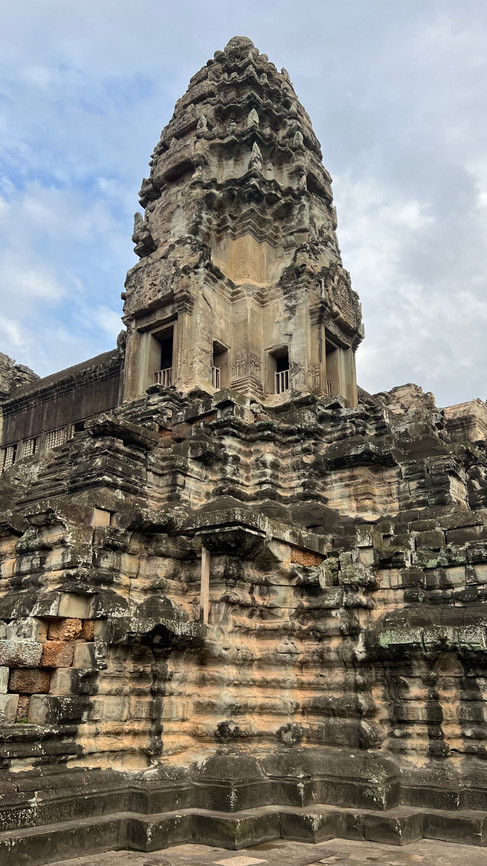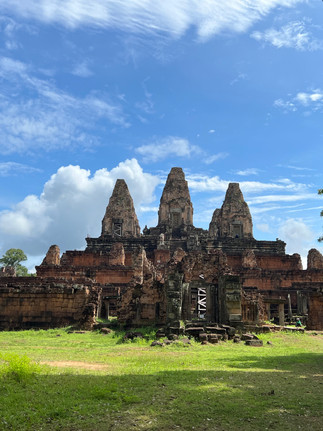Visit the archaeological site of Angkor Wat (Cambodia)
- Mia Caudet
- Oct 8, 2022
- 10 min read
The Angkor Wat temple complex in Cambodia is one of the most incredible places to see in Southeast Asia and is the main tourist attraction in Cambodia, although not the only one. I recommend that if you are only thinking of making a stop in Cambodia to visit the temples, read my complete travel guide to Cambodia first, where I include many incredible destinations in the country that are worth knowing.
To visit the temple complex, you must arrive in the city of Siem Reap, located in the Angkor region, in northern Cambodia. Ideally, you should dedicate 3 days to visit the entire temple complex + 1 or 2 extra days to get to know the city of Siem Reap and some incredible places that are very close.
In this post you will find a complete guide to visit the temples of Angkor Wat and many tips to not miss anything. At the end I also add links to other articles that may interest you to organize your trip to Cambodia.
COMPLETE GUIDE TO VISIT THE ARCHAEOLOGICAL SITE OF ANGKOR WAT, CAMBODIA
Brief history of Angkor Wat
Angkor is a huge complex of Hindu and Buddhist temples located about 5 km from the city of Siem Reap, in northern Cambodia.
These temples were built at the height of the Khmer Empire during the 9th and 15th centuries. The most important temple in the complex is Angkor Wat, a symbol of Cambodia and declared a World Heritage Site by UNESCO in 1992.
After the end of the Khmer empire, the temples were abandoned and fell into oblivion and were literally eaten by the jungle, with the exception of Angkor Wat. The main temple was continuously inhabited by Buddhist monks.
They say that the city was completely forgotten and rediscovered in the 19th century by the French naturalist Henri Mouhot, who came across the temples while hunting butterflies. Although, there are many who claim the achievement of having found the temples in the middle of the jungle and the truth is that the Cambodians never forgot that the temples of Angkor were near Siem Reap. Also, there have always been Buddhist monks inhabiting the Angkor Wat temple.
Prices to the archaeological complex of Angkor Wat
To enter the archaeological park of Angkor Wat you have to pay an entrance fee.
Ticket for 1 day: US$37
Ticket for 3 days: US$67
Ticket for 5 days: US$72
*The rates are those of 2022. From 12 years. Children under 12 years are free.
I recommend you to organize the visits in 3 days (below, I will detail the temples for each day and the route to follow). With just 1 day you will hardly have time to see anything, at most the main temple Angkor Wat (and I assure you that there are temples that make you fall in love much more).
In our case we bought tickets at the box office (something I recommend). Buying them online has the same rate, but with the inconvenience that they are not refundable.
Tickets for 3 or 5 days are not for 3 consecutive days. In other words, if you are going to spend 5 days in the Siem Reap area, you can visit the Angkor temples one day, the Tonlé Lake another day and the next day return to Angkor Wat. They stamp your entry as you have entered a day, regardless of when it is and you have a maximum of 30 days to consume it.
Tickets come with a photo, so they are not transferable.
In our case, we bought tickets for 3 days and they gave us 2 more days. It is something they usually do in low season.
How to tour Angkor Wat
The Angkor Wat complex is huge and although there are areas that you must visit on foot, there are others that you must use some type of transport. You must bear in mind that there are routes of up to 30 kilometers.
Tour the temples of Angkor by tuk tuk
You have several options, although I recommend hiring a tuk tuk for 4 or 5 hours. The tuk tuk and hotel drivers have agreed prices (although on the street you can haggle a little more) and they have 3 circuits through the different temples. The shortest circuit that includes Angkor Wat is around $15-20. The medium circuit costs 20-24$ and the long circuit about 30$. A medium tuk tuk can fit 4 people. Which is very profitable and affordable. In addition, you will have the advantage that it will go at your own pace.
Tour the temples of Angkor by bike
You can also visit some of the circuits by bicycle (I recommend the short one). In general, they are organized tours and you will go with a guide.
Tour the temples of Angkor by car or van
Although it is the most expensive option, if you travel in the hottest months it is a good alternative since you will have air conditioning during the journey.
We traveled in May and had temperatures between 35-38ºC at noon. And even so, we opted for the tuk tuk since the price was considerable and considering that to visit the temples it is advisable to start at dawn (at 5am) we did not find it necessary to do it by car.
How NOT to visit the temples of Angkor
In elephant. There are still some companies (less and less) that offer this type of tours on the back of elephants. We travel in low season and I did not see anyone doing it, although you do find advertising brochures in the hotels. I find it a horrible option and I never recommend options that include animals (in any destination).
Best time to visit Angkor Wat
I definitely recommend getting up early every day and leaving the city of Siem Reap around 5-5:30. Dawn is the best time to visit the temples without dying of heat. It is true that some temples open at 7:00 am, although not the main ones. So I recommend you to be on the premises at 6:30 at the latest and take advantage of these low-heat hours.
The circuits usually last about 4 or 5 hours, so around 10 or 11 in the morning you can be back at the hotel (just when the humidity and heat begin to be unbearable) and take advantage of the hotel pool or A city tour…
Essential temples to see in Angkor Wat
Angkor Wat, the most essential temple to see in Siem Reap
It is one of the largest and most impressive Hindu temples in the world. It was built in the 12th century and is a clear example of Khmer architecture.
It was built to be a Hindu temple, its five towers symbolize the Hindu universe and it is surrounded by walls and a moat that in the past was full of crocodiles.
After several centuries of wars, finally at the end of the 16th century it was abandoned. The entire Angkor site was buried by the jungle, with the exception of the main temple, Angkor Wat, which was maintained and continued to be inhabited by Buddhist monks.
Legend has it that it was not until the end of the 19th century, when the French naturist Henri Mouhot, who was in the area exploring and looking for butterflies, found the temples again. Although the story is not entirely true since he was not the first Westerner to be in the area and discover the temples beforehand and this is documented in some previous expeditions, in addition to the fact that the Cambodians never forgot Angkor Wat and the monks lived there throughout moment.
The history that surrounds Angkor Wat is fascinating and although a good option is to visit the temples on your own, if you are interested in knowing its history it is advisable to hire a guide. (I'll explain the different options you have later).
The best time to visit the temple is at dawn, not only to enjoy the sunrise but also because the heat and humidity are not yet intense. So be here at 5 am and you will discover this wonder of a place with the first light of dawn.
The enclosure is huge. First you will go over a bridge until you reach the first building. A fortified area where you find the first colonnades and dark corridors that lead you to different statues of Buddhas. As soon as you leave this first building you find yourself in front (about 500 meters) of Angkor Wat and two small temples on its sides.
As soon as you enter Angkor Wat you can follow different paths and enter through different entrances. There are different interior patios and corridors through which you can discover the engravings on its walls, statues...
Bayon Wat and its more than 100 faces
Bayon Temple is located in the center of Angkor Thom (The Great City). It was built by King Jayavarman VII during the 12th and 13th centuries.
The center of the temple is carved with more than 200 huge faces spread over 54 towers whose number represents the 54 provinces into which Cambodia was divided at the time of construction.
The four faces of each tower are images of King Jayavarman VII to represent his omnipresence. Although some say that the faces represent Buddha in the future.
Don't just tour the temple outside. You have the quick option, which is to go around the temple in a circle on the outside, appreciating all the sides of the façade.
But you can also enter to tour the temple inside. You will find dark corridors, dimly lit, that lead to internal courtyards. You can go up and down stairs and get lost in the small labyrinth that this temple looks like. Warning! It is the temple where we find more spider webs and of course spiders. They are huge! I imagine that, being a temple so closed, damp and dark, it is the favorite place for its current inhabitants.
Ta Prohm, the most magical temple to see in Angkor Wat
This is the most beautiful temple in the entire archaeological site (in my opinion). The immense trees that have grown between the temples form a perfect and precious set. Making this place a very special place to see in Siem Reap. It is preserved practically the same as at the time of its discovery, although they have had to clean up minor vegetation to make way for visitors.
In our case we arrived just at 7am, when it opened and we walked through it completely alone. An incredible experience that I recommend.
It was built by King Jayavarman VII as a Mahayana Buddhist monastery and university, so its architecture is very different from other Angkor temples.
As you go through the temple you realize that you will have to dodge huge rocks (which were part of the structure of the temple in the past) and several huge tree roots.
Baphuon Wat
The Baphuon Wat was built in the 11th century and was dedicated to Shiva, the Hindu god. Later, in the fifteenth century the temple became Buddhist. Climb to the top to have some nice views of the area, although beware of the steps that are half destroyed and at different heights.
Phimeanakas Wat
Phimeanakas Wat is a Khleang-style Hindu temple built in the late 10th century.
Legend has it that the king spent the first watch of each night in the tower with a Naga woman (serpent woman in Hindu mythology). During that time not even the queen could disturb him. On the second watch the king returned to the palace with the queen. If Naga did not appear one night, the king's days were numbered, and if the king did not appear, his kingdom would suffer a calamity.
Banteay Samre Wat
This temple was built in the 12th century by Kings Suryavarman I and Yasovarman II. It is a Hindu temple built with sandstone. This temple was also buried by the jungle, but unlike Ta Prohm, where the trees literally grew between the buildings, here you find the best defined and preserved parts of the temple. It is usually one of the least visited temples, so silence and peace usually reign.
Pre Rup Wat
Pre Rup is a Hindu temple built by Rajendravarman II in the 10th century. It stands out for its pyramids and its good state of preservation. It has two walls that surround the temple and you will have to climb some steep stairs to reach the top and admire the central pyramid from up close.
In front of the temple there are several rice fields and it is not difficult to see the buffalo taking their morning bath.
Preah Koh Wat
The name Preah Ko (Sacred Bull) originates from the three sandstone statues that face the temple towers and are located in the front. These statues represent Nandi, the white bull that serves as a mount for the god Shiva. It is a Hindu temple built in the 10th century and is in the Khmer empire style.
Ta Som Wat
This is one of the smallest temples you will find within the enclosure of the Angkor archaeological site. It was built in the late 12th century for King Jayavarman VII. The king dedicated the temple to his father Dharanindravarman II, who was King of the Khmer empire from 1150 to 1160.
In it are also huge trees embedded in the temple. In this case they have had to cut some or kill the roots so that they do not continue destroying what remains of the temple.
East Mebon Wat
The Eastern Mebon is a Hindu temple built in the 10th century during the reign of King Rajendravarman. In the past, it stood out because it was built in the center of a small artificial island, which is currently dry and grassy. The temple was dedicated to Shiva and honors the king's parents.
It is one of the best preserved temples. You will have to climb several flights of uneven stairs to reach the top and enjoy incredible views. Also, once you get to the top, you can tour the temple and even enter some of its pyramids (not all of them were open for access). In each corner of the main platform there are huge sculptures of elephants and lions.
Clothing in Angkor Wat
It is important to dress appropriately to visit the Angkor Wat temple complex. It is not allowed to enter the temples with shorts (Above the knee) or sleeveless shirts, both for men and women. Although this rule only applies to women and they turn a blind eye to men (something we were able to verify in the first person).
In addition to the dress code there are several more rules such as; Do not photograph the monks, do not feed the monkeys…
Interesting tours to do in Angkor Wat
If you do not want to go it alone and you are interested in knowing the temples with the help of a local guide, you can hire one of these tours. In addition, some have a guide in Spanish, a great advantage for those who do not handle languages perfectly.
What to see and do in Siem Reap
Siem Reap is a city with many things to do. From knowing the temples of the city, to visiting its markets, knowing some little-known and very interesting museums to knowing some secret places. The ideal way to get to know the temples and all the places of interest in the city is to spend 5 days in this area of Cambodia. If you want to discover what to do in Siem Reap do not miss:
PLAN YOUR TRIP STEP BY STEP
I hope you enjoy your trip to Cambodia a lot and that this article has been useful to you. You can continue reading many more related articles on the blog.
If you liked this article, subscribe to the blog so you don't miss the next destinations, curiosities, travel tips and inspiration for your trips.
A hug and see you soon!



















































Comments